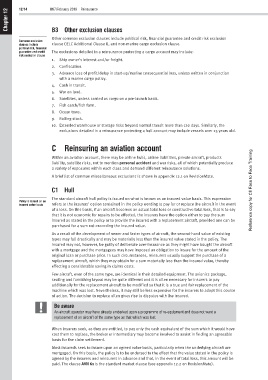Page 344 - M97TB9_2018-19_[low-res]_F2F_Neat2
P. 344
12 12/14 M97/February 2018 Reinsurance
Chapter B3 Other exclusion clauses
Other common exclusion clauses include political risk, financial guarantee and credit risk exclusion
Common exclusion
clauses include clause (JELC Additional Clause I), and non-marine cargo exclusion clause.
political risk, financial
guarantee and credit The exclusions detailed in a reinsurance protecting a cargo account may include:
risk exclusion clause
1. Ship owner’s interest and/or freight.
2. Confiscation.
3. Advance loss of profit/delay in start-up/marine consequential loss, unless written in conjunction
with a marine cargo policy.
4. Cash in transit.
5. War on land.
6. Satellites, unless carried as cargo on a pre-launch basis.
7. Fish catch/fish farm.
8. Ocean tows.
9. Rolling stock.
10. Extended warehouse or storage risks beyond normal transit more than 120 days. Similarly, the
exclusions detailed in a reinsurance protecting a hull account may include vessels over 25 years old.
C Reinsuring an aviation account
Within an aviation account, there may be airline hulls, airline liabilities, private aircraft, products
liability, satellite risks, not to mention personal accident and war risks, all of which potentially produce
a variety of exposures within each class and demand different reinsurance solutions.
A brief list of common miscellaneous exclusions is shown in appendix 12.1 on RevisionMate.
C1 Hull Reference copy for CII Face to Face Training
The standard aircraft hull policy is issued on what is known as an insured value basis. This expression
Policy is issued on an
insured value basis refers to the insurers’ option contained in the policy wording to pay for or replace the aircraft in the event
of a loss. On this basis, if an aircraft becomes an actual total loss or constructive total loss, that is to say
that it is not economic for repairs to be effected, the insurers have the option either to pay the sum
insured as stated in the policy or to provide the insured with a replacement aircraft, provided one can be
purchased for a sum not exceeding the insured value.
As a result of the development of newer and faster types of aircraft, the second-hand value of existing
types may fall drastically and may be materially less than the insured value stated in the policy. The
insured may not, however, be guilty of deliberate over-insurance as they might have bought the aircraft
with a mortgage and the mortgagees may have imposed an obligation to insure for the amount of the
original loan or purchase price. In such circumstances, reinsurers usually support the purchase of a
replacement aircraft, which they may obtain for a sum materially less than the insured value, thereby
effecting a considerable saving in claims costs.
Few aircraft, even of the same type, are identical in their detailed equipment. The avionics package,
seating and furnishing layout may be quite different and it is often necessary for insurers to pay
additionally for the replacement aircraft to be modified so that it is a true and fair replacement of the
machine which was lost. Nevertheless, it may still be less expensive for the insurers to adopt this course
of action. The decision to replace often gives rise to disputes with the insured.
Be aware
An aircraft operator may have already embarked upon a programme of re-equipment and does not want a
replacement of an aircraft of the same type as that which was lost.
When insurers seek, as they are entitled, to pay only the cash equivalent of the sum which it would have
cost them to replace, the broker or intermediary may become involved to assist in finding an agreeable
basis for the claim settlement.
Most insureds seek to insure upon an agreed value basis, particularly when the underlying aircraft are
mortgaged. On this basis, the policy is to be endorsed to the effect that the value stated in the policy is
agreed by the insurers and reinsurers in advance and that, in the event of total loss, this amount will be
paid. The clause AVN 61 is the standard market clause (see appendix 12.2 on RevisionMate).

